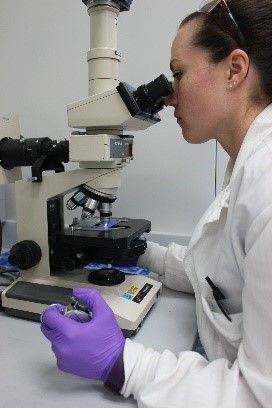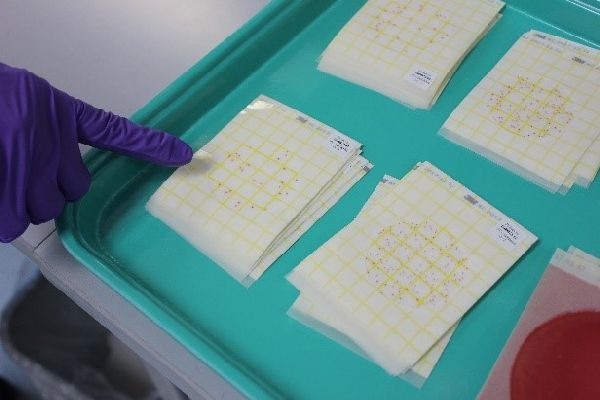Alaska Dairy Program
The Alaska Department of Environmental Conservation (DEC) Office of the State Veterinarian (OSV) is responsible for managing Alaska’s Grade “A” dairy program. This program includes the regulation of Grade “A” milk production and the processing, distribution, and sale of milk, fluid milk products and cheese to the public. At this time all 50 states have state-run dairy programs that are FDA-approved. Having a state-run dairy program ensures that Grade “A” dairy farms have market access to all stores that want to sell their milk, from small local stores to large retail chains as well as providing milk for hospitals, daycare and school meal programs. It also ensures that consumers have access to safe and wholesome milk from local Alaskan producers.
We are happy to answer any questions you may have! For questions about the dairy program, call 907-375-8200. You may also contact Dr. Sarah Coburn, State Veterinarian, for more information.


The United States Public Health Service Food and Drug Administration (USPHS/FDA) Grade “A” Pasteurized Milk Ordinance (PMO) is the main dairy regulatory document utilized across the United States. It provides a framework for the safe production, processing, and distribution of milk and fluid milk products. The PMO has been adopted into Alaska State Statutes 18 AAC 32.010 – 18 AAC 32.060. These laws exist to ensure milk and fluid milk products (milk, cream, half-and-half, yogurt, buttermilk, etc.) entering commerce are manufactured, sold, and delivered in a safe and wholesome condition. The production and processing of milk is an extremely complex process that requires knowledge of animal health, animal husbandry, food safety and sanitation, the function and operation of milk collection equipment, and an understanding of milk processing and the operation of pasteurization equipment.
18 AAC 32 has been amended effective March 26, 2023 to include 18 AAC 32.070, allowing direct-to-consumer sales and sales at registered markets of raw milk and raw milk products from registered producers. To find out more about raw milk sales and how to register to conduct sales, please visit our raw milk webpage.
Each producer and processor of Grade “A” milk must have a permit from DEC OSV. The process for obtaining a permit for the production or processing of Grade “A” milk includes:
- Submitting proposed blueprints of the facility for approval by OSV
- Meeting state water and waste water disposal standards
- Inspection by OSV once the facility is ready for operation
- Submitting product labels for approval by OSV
- Acceptable test results from the analysis of raw milk and/or fluid milk products from the facility
- Additional requirements defined under 18 AAC 32.010 – 18 AAC 32.060 and in the Grade “A” Pasteurized Milk Ordinance.
To maintain these permits, dairy producers and dairy processors must be in compliance with state regulations and the PMO. The OSV conducts regular inspections of these facilities and collects samples of raw milk and pasteurized milk products for laboratory testing to validate food safety and quality standards. Samples of milk are collected and tested monthly. Dairy farms are inspected every 6 months while milk processing plants are inspected quarterly. Additionally, all pasteurization equipment is tested quarterly by OSV to ensure it is operating properly to achieve effective pasteurization temperatures.
If you would like more information on how to obtain a permit for dairy production or processing, please contact the Alaska Dairy Program.
In addition to inspections by the OSV and monthly regulatory surveillance testing of raw milk prior to pasteurization and final pasteurized milk and milk products, each processor must perform antibiotic drug residue screening on their raw milk supplies. This involves setting-up and operating a milk screening laboratory to serve each processing facility. Each milk screening laboratory must be certified by a Laboratory Evaluation Officer (LEO) who is part of the Alaska State Environmental Health Laboratory’s Laboratory Certification Program. The LEO provides technical assistance throughout the certification process, prepares annual proficiency tests for analysts, and visits the laboratory every two years to review laboratory and analyst practices.
For more information on milk screening laboratory certification, please contact the Laboratory Certification Program.
The Alaska State Environmental Health Laboratory (EHL), is the FDA-approved State Central Milk Laboratory for Alaska. The EHL performs official regulatory testing of milk, milk products, and milk containers collected by the Alaska Dairy Program staff during surveillance sampling. They also perform microbiological testing of cheese samples from manufacturers located within the state.
Grade “A” dairy products are tested each month for
- Coliform Bacteria
- Generic Bacteria
- Antibiotic Drug Residues
- Somatic Cells
- Phosphatase
Cheese is tested for
- Listeria monocytogenes
- Staphylococcus aureus
- Salmonella
- E. coli


Grade “A” dairy farms and dairy processing plants may choose to have biennial inspections by a Sanitation Ratings Officer in order to be listed on the Interstate Milk Shippers (IMS) list. This allows processors to sell their product in other states. Although Alaska dairy processors generally don’t sell their products across state lines, the IMS listing allows market access to buyers such as military bases, schools, and other facilities that receive federal funding.
The IMS listed facilities in Alaska can be found on the FDA Interstate Milk Shippers List website.
In accordance with 18 AAC 32.060, raw milk may be sold to a Grade “A” milk processing plant or for animal feed. 18 AAC 32 has been amended effective March 26, 2023 to include 18 AAC 32.070, allowing direct-to-consumer sales and sales at registered markets of raw milk and raw milk products from registered producers. To find out more about raw milk sales and how to register to conduct sales, please visit our raw milk webpage. Additionally, unpasteurized milk from a permitted Grade “A” milk producer can be used to make certain aged cheeses (see “Sources of Milk for Cheese Manufacturing” below). State regulations do allow owners of the animals to consume raw milk and raw milk products.
- Raw Milk Food Safety, US Center for Disease Control and Prevention (CDC)
- Raw Milk Questions and Answers (CDC)
- Raw Milk Misconceptions and the Danger of Raw Milk Consumption, US Food & Drug Administration (FDA)
- The Dangers of Raw Milk: Unpasteurized Milk Can Pose a Serious Health Risk US Food & Drug Administration (FDA)
- Foodborne illness outbreaks linked to unpasteurised milk and relationship to changes in state laws – United States, 1998–2018 (Epidemiology and Infection journal article)
Alaska state statute AS 17.20.015, passed by the Alaska Legislature and signed into law by the governor in 2021, defines the “shared ownership of milk-producing animals.” The law became effective on September 29, 2021. Prior to this statute, state regulations permitted the consumption of raw milk, or products made from raw milk, if the milk was produced by an animal the consumer owned. Currently, state regulations 18 AAC 32.010 – 18 AAC 32.060 do not apply to owners of a cow, sheep, or goat who use the milk produced by the animal for personal use.

The Office of the State Veterinarian (OSV) is responsible for the regulatory oversight of cheese manufacturing in Alaska through Alaska State Statutes 18 AAC 32.210 – 18 AAC 32.295.
These laws exist to ensure cheeses manufactured in Alaska and entering commerce are manufactured, sold, and delivered in a safe and wholesome condition.
Cheese manufacturers in the state of Alaska require a permit issued by DEC OSV. The process for obtaining a permit for the production of cheese includes:
- Submitting proposed blueprints of the facility for approval by OSV
- Submitting a description of cheese products and the method of production
- Submitting product labels for approval by OSV
- Inspection by OSV once the facility is ready for operation
- Acceptable test results from the collection and analysis of cheese products produced by the facility
- Additional requirements defined under 18 AAC 32.210 – 18 AAC 32.295
To ensure compliance with the regulation, all activities for permitted cheese manufacturing facilities are inspected by OSV. Surveillance cheese samples for new products and ongoing production are collected and analyzed for Listeria monocytogenes, Salmonella, E. coli, and Staphylococcus aureus. These tests are completed bi-annually on all cheese products by the Environmental Health Laboratory.
If you would like more information on how to obtain a permit for cheese manufacturing, please contact the Alaska Dairy Program.

Cheese manufacturing under 18 AAC 32.210 – 18 AAC 32.295 must be made with Grade “A” milk in the state of Alaska.
While some may find it more efficient or economical to use milk from their own Grade “A” dairy, others may find purchasing Grade “A” milk from a supplier is more fitting for their operation.
Cheese may be made from raw or pasteurized milk. Raw milk may be used for some cheeses, however, raw milk used to make cheese must originate from a permitted Grade “A” dairy supplier per Alaska State Statute 18 AAC 32.250. Specific aging and temperature requirements apply for raw milk cheeses which are defined in the Code of Federal Regulation 21 CFR 1240.61 and 21 CFR Part 133.18 AAC 32 has been amended effective March 26, 2023, to include 18 AAC 32.070, allowing direct-to-consumer sales and sales at registered markets of un-aged raw cheese from registered producers. To find out more about raw cheese sales under 18 AAC 32.070 and how to register to conduct sales, please visit our raw milk webpage.
Milk Producer and Processor Resources
- Alaska Dairy Regulations
- Grade “A” Pasteurized Milk Ordinance, 2019 Revision
- US FDA Interstate Milk Shippers List
- National Conference on Interstate Milk Shipments
- University of California Davis Food Safety, Dairy Products Resources
- Dairy Practices Council
- National Dairy Farm Program
- FDA National Milk Drug Residue Database
Cheese Manufacturing Resources
- Alaska Cheese Regulations
- University of Alaska Cooperative Extension Service
- American Cheese Society, Best Practices Guide for Cheesemakers
- The Safe Cheesemaking Hub, Food Safety Resources for Cheesemakers
- University of Maine Cooperative Extension: Food & Health, Sanitation and Food Safety for Cheesemakers
- PennState Extension Sanitation Tips for Small-Scale Cheese Plants
- University of California Davis Food Safety, Dairy Products Resources

 Indicates an external site.
Indicates an external site.